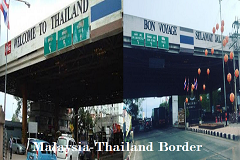Importance of Hydroplaning in High Precipitation Regions: Strategy for Malaysian Drivers
- On Apr, 12, 2022
- Ch. Mahmood Anwar
There are many descriptions of Hydroplaning as reported by many authors, but to sum it all up in a simplified manner, Hydroplaning can be described as skimming and sliding of the tires of a high-speed vehicle on a road surface due to a stagnant puddle of water or a thin film on top of the water, especially during rainy days.
Hydroplaning can sometimes be referred to as aquaplaning. Factoring in the destruction of rhythmic flow of traffic leading to a grid lock or a nightmare of avoidable accidents thus being a nuisance to the normal everyday life. With a high precipitation rate due to its geographical positioning and a deteriorating drainage system of roads, Malaysia has become prone to many occurrences of Hydroplaning.

Being a tropical highland, Malaysia receives a high amount of precipitation, with statistics showing that for the past decade Malaysia received an average of about 366.94 mm of rainfall annually, which ultimately doesn’t help with the problem faced with Hydroplaning, therefore, Malaysian drivers have a tougher job due to increase in the occurrence of Hydroplaning on major roads both urban and rural.
Since independence Malaysia has grown into a rising economic powerhouse in the south-east Asian region, having an increase in the use and ownership of automobiles with a total number of 19 million in 2009 and expected to exceed to 48 million in 2020, this has also led to the increase in infrastructure development in the whole region so as cater to the need for good and modern roads for access use.
Instances of Hydroplaning
A closer look at the difficulties caused by Hydroplaning sees a number of increased accidents on all major roads and highways in the region, unfavorable weather conditions have had a negative effect on road surfaces and one of the major causes of road accidents and road fatalities.
Daily, approximately 18 traffic accidents occur in the peninsular Malaysia that causes on an average one death in every hour, with nearly 40% of the accidents that occur being caused by hydroplaning. Which in turn also increase the occurrence of snarl-up and grid-locks in the major urban areas of Malaysia.
The Malaysian government has put up measures to mitigate the occurrence of road carnages, but this has proven to be a steep slope for the public works and the government at large, though with the erection of road signs, especially signs to indicate slippery areas, and improving drainage on the roads. Unfortunately, accidents caused by Hydroplaning seem to increase with the many cautions being arrayed by the respective officials.
With improved studies from well developed countries like the US and strategic guidance in the driving instruction institutions, the world is well on its way to improve drivers’ efficiency on how to easily tackle incidences of Hydroplaning on all major roads, and Malaysian drivers shouldn’t be left behind.
Though there are not many hazardous repercussions directly linked with Hydroplaning, a lot of other issues can be indirectly linked with Hydroplaning, like snarl-ups due to slow driving or a gridlock can lead to damaged goods on transit a slower provision of essential services which would in turn lead to slow economic growth.
A quick look at the causes of hydroplaning will help give insight into this phenomenon.
Causes of Hydroplaning
To be well informed on how to avoid incidences of Hydroplaning, one must look at the causes that may lead to a car or any automobile to hydroplane. Hydroplaning has several contributing factors though the most determining factor is water or a liquid with low viscosity. But a deeper and closer approach shows that there are a number of factors that will definitely lead to aquaplaning in addition to this primary factor.
• Water Depth
High precipitation areas may lead to settling of large puddles of water in the road surface. These water surfaces will lead the car tires to relatively have a smaller surface area to the road surface increasing the occurrence a car’s slippery motion over the road surface. This makes it hard to control the car in such surfaces and further increases the risk of accidents.
• Roads Condition
The road surface is also a factor to be considered, with most Malaysian roads being in overall bad condition and not well managed, the number of potholes and general condition of the road may lead to a vehicle to slipping or sliding as it moves on the surface. Oils used in tarmacking can be lubricated with the addition of water on the surface creating a slippery surface. Pavement ruts, texture and grade/width are also factors in Hydroplaning.
• Wear and Tear
Most drivers and motor vehicles owners usually use their automobiles without frequent checkups with their mechanics as a way of saving a few cents. This has turned out to be costly since most Hydroplaning incidences occur from the wear and tear of tires. The tread wear might definitely lead to a car sliding or skimming amid the imperfect conditions. Tread aspect ratio, tires width and tire inflation can also lead to Hydroplaning related accidents.
Hydroplaning Prevention
To many drivers the formalities required with dealing with authorities and the painstaking negotiations with insurance agencies makes most automobile owners overlook taking such insurance policies, although the costs involved is also a factor. A good look at how to prevent the occurrence of Hydroplaning is vital in the daily lives of automobile operators, more so for frequent road user like truckers who are ever on transit and can easily tire on the steering wheel.
In order to prevent such accidents, drivers need to take the following precautions during rainy seasons or on the occurrence of heavy rainfall. Preventing Hydroplaning can be somewhat a tough fix, but there are certain measures, which would definitely help solve the issue of Hydroplaning such as:
• Avoiding Watery Surfaces
This may seem an unintelligent way to solve this problem or an easy thing to do, but is rarely practiced by most drivers. The best way to avoid watery surfaces is to practically stay indoors in the onset of rain. If there is need for one to travel through a rainy day avoiding pools and puddles of water on the road surface can help reduce the risk of Hydroplaning, also avoiding driving on the curbs, where water would settle, and cruising on the road at the center also helps reduce the risk of one’s vehicle Hydroplaning.
• Speed
There is no doubt that most individuals tend, especially in urban centers, to be in a hurry and most drivers epitomize this habit vividly. It is advisable for drivers to reduce speeds while driving in rain, since, at high speeds the tire’s contact to the surface road is minimal and with the addition of a watery surface there is a high possibility of the vehicle skidding on the surface thus Hydroplaning which may lead to head-on with oncoming traffic. So slowing down during a high precipitation or in the case of abruptly encountering a wet surface road while driving can be very helpful in the long-run in easing Hydroplaning damages.
• General Maintenance of Car
Regular check-ups with the mechanic are also crucial in overall car maintenance. Sometimes most vehicles on our roads are over-used without regular checkups for wear and tear. These wear on the tire thread, leads to loss of grip of the tire’s grooves on the road surface and with addition of rain water may cause the vehicle to hydroplane. Most Hydroplaning occurrences are linked to the tire’s conditions, be it the tire’s width, it’s thread aspect ratio or the tire’s inflation. Some tires are manufactured with deep threads and grooves to help disperse water quite easily.
• Choice of Road Surfaces in Rainy Season
Another crucial issue that most drivers usually forget is to avoid out-roads and un-tarmacked roads which after contact with water or rainfall become dump and slippery creating a sludge like surface which with its low viscosity can lead to a vehicle losing traction with the surface. However, some oils used in the process of tarmacking the road can also react with water and cause a lubrication between the surface and the tires.
You are Hydroplaning: Do You Know?
When driving, a sudden feel of steering loss or a half or full swerve of the vehicle on a wet terrain, is a clear indicator that a driver is Hydroplaning. The best way and the first most important thing in such an emergency is not to panic, which may lead to imprudent decision-making. The driver needs to be calm and composed in such instances and gradually easing off the gas is essential as this reduces acceleration and makes the vehicle’s momentum to slow thus steadily coming to a stop which will help beat the swerve.
In cases of aggravated hydroplaning, the best solution is for the driver to steer against the skid or swerve. Which can be achieved by steering counter-clockwise to the swerve, but this needs to be done with precise execution, so as not to make the car spin off-road. One thing that is important is not at any time to slam the breaks but most drivers panic and ignore this. Hitting the breaks, with the car already losing traction with the surface at a certain speed, causes the vehicle to make full swerve and spin out of control thus losing the little control that was to be gained to get out of the situation safely. After all these counter measures are applied the driver has to just wait for the car to gain traction and reconnect with the road surface and continue on course.
For drivers in high precipitation regions in Malaysia, hydroplaning can have quite an effect on the driver’s emotions and psyche. Spikes of adrenaline, panic, fear are some of the emotions the driver feels when encountering such incidences and are perfectly natural body responses. However, it is better for the driver to try and take a breather off road, so as to recollect and calm his or her nerves before venturing back on the road to tackle the wet surfaces and puddles once again.
Conclusion
Regardless of the counter measures put in place, a series of other unfortunate events can at times eventually lead to the occurrence of vehicle to hydroplane. With this in mind individual driver’s efforts are key to successfully counter hydroplaning. The government is also at fault for not ensuring roads are in shape to safeguard against hydroplaning. The measures put in place are just not good enough. Another key player in ensuring information on weather conditions is available is the meteorological department; information from this department is crucial in ensuring drivers plan efficiently.
The traffic police in Malaysia should ensure that drivers who violate traffic rules are arrested and prosecuted, this will go a long way in ensuring there is order on the roads. This measures put in place would certainly provide a platform to minimize the damages caused by hydroplaning on Malaysian roads.




















